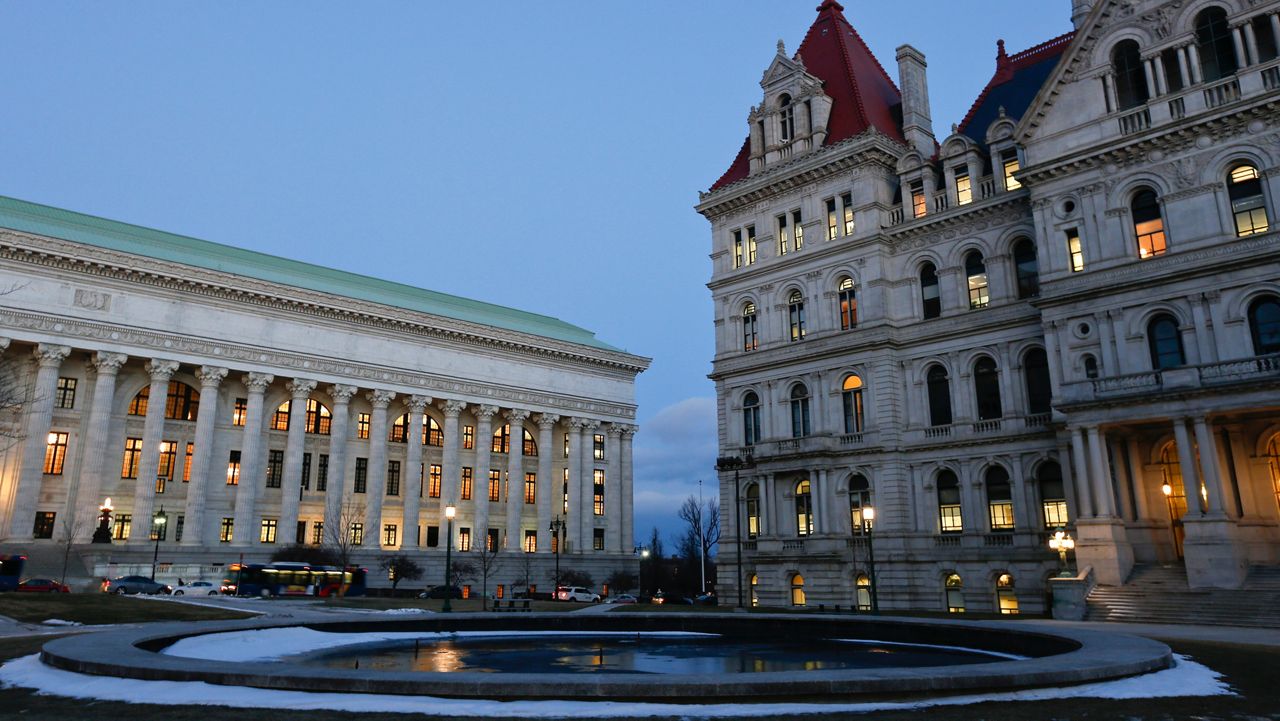The concourse of the Empire State Plaza, just outside of the convention center where Gov. Andrew Cuomo later on Wednesday will deliver his 10th State of the State of the address, was getting a redecoration on Tuesday evening.
Workers hoisted banners highlighting year-by-year accomplishments of the last decade. One banner feted the creation of the downtown revitalization initiative in 2016. Another banner celebrated the completion of the Gov. Mario M. Cuomo Bridge, which replaced the Tappan Zee Bridge, in 2018.
The theme was pretty clear: Look at these accomplishments that have spanned a decade of churn and change.
But the new year is also bringing both old and new challenges for Cuomo and Democratic-controlled state Legislature.
Consider the new:
- New York’s budget gap stands at $6.1 billion, a hole that’s unusually large during a non-recession. The size of the gap is giving pause to fiscal hawks, who worry the state won’t be prepared for the next economic downturn. Solutions are slim. Some lawmakers are pressing for tax hikes on the rich, a move Cuomo has stiff armed.
- The Medicaid program faces a $4 billion budget hole, meanwhile, and the Cuomo administration is already moving to cut 1 percent of spending. Hospital groups and health care labor unions remain a politically potent force in New York politics, making any efforts to control Medicaid spending politically tricky and cumbersome.
- There’s nothing new about anti-Semitism, but there’s been a sickening rise in the number of hate crimes directed at the Jewish community in recent years, recently released statistics show. High-profile incidents, like the stabbing of five people in Rockland County during a Chanukah gathering, and Cuomo and lawmakers may be spurred to take further action this year on the issue. The governor has already hinted at plans to push for new domestic terrorism charges for those accused of hate crimes.
And consider the old:
- Marijuana legalization remains a puzzle box for the Legislature. All the old questions about traffic safety, who should be eligible for a license and how the revenue should be spent remain. Added to the discussion is the public health concerns surrounding vaping products, which Cuomo over the summer said he wanted to roll into the cannabis legalization debate. Lawmakers and Cuomo agree, broadly speaking, there’s a need to legalize cannabis as they did last year. Ultimately the agreed-upon plan was to decriminalize marijuana-based offenses and expunge records. It was a move activists were displeased with, but supporters said was a significant step. The problems remain in the nettlesome details.
- Cash bail law changes will continue to be a point of contention amid a sustained pressure campaign from local government and law enforcement officials. Democratic lawmakers from suburban legislative districts, will be especially key to watch during the process amid increased calls to add judicial discretion to the cash bail legislation. Criminal justice reform advocates want to keep largely in place the changes, which ended cash bail requirements for misdemeanor and non-violent felonies at the start of the year. But the drumbeat of headlines — and Republican capitalization on them — is becoming difficult for Democrats to ignore.
It’s an election year, but not for Cuomo.
The governor has telegraphed he’s seeking a fourth term in 2022 (and really, why not, considering he wouldn’t want to appear to be a lame duck midway through the third). But a midterm Cuomo is in contrast to the Legislature, where all 213 seats are up for re-election in 2020.
- In Albany, New Yorkers Have a Lot At Stake
- 3 Issues That Will Dominate New York's 2020 Legislative Session
- State Lawmakers Return to Albany As Bail Law Tensions Rise
The election dynamic once again will likely be two-fold.
One front will be in suburban and upstate districts between Republicans and Democrats. The Senate GOP, in particular, will try to flip Long Island seats Democrats won in 2018 in their bid to claw back their way to the majority. That’s going to be a challenge, considering the dizzying number of retirements over the last several weeks among the Republican conference in the chamber.
The other front will be the continuation of the march of progressive candidates running to unseat longtime incumbents in Albany. Rep. Alexandria Ocasio-Cortez’s victory remains a tantalizing template for any progressive challenger.
Cuomo is surely aware of these dynamics and their pressure points for the Legislature and individual lawmakers. He has the structural upper hand in the state budget, intrinsic power that can enable him get largely what he wants.
And yet, lawmakers last June showed they were willing to work between their two houses to get sweeping deals on issues like rent control and driver’s licenses for undocumented immigrants accomplished.



